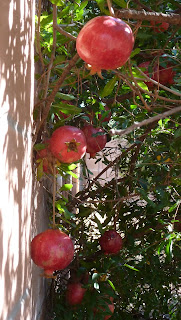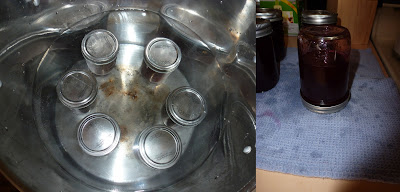I don't know about you, but I have a
TON of pomegranates right now. My poor little tree went crazy this
year and she's weighing herself down with all the fruit she has!
Every year I make jelly, syrup, and
maybe one or two things more using the fruit, but this year, since
she gave me so much extra, I'm making everything and then some and I
wanted to share all my adventures with you!
That being said, let's start with the
obvious first step: getting those peels off the pomegranate and
freeing up those gorgeous and deliciously tart seeds.
There are a few different ways of doing
this, but the way I know best is the one I'll show you today. I find
this method allows me to get the most of the fruit/juice out of each
pomegranate, but it can also be the most time consuming.
To do this, you will need:
Pomegranates (Duh! ;))
A knife
Two large bowls, one filled 1/3rd
of the way up with water.
A straining spoon/slotted spoon
A trashcan or bag
Some free time and a lot of patience.
Optional (but highly recommended as the juice sometimes splatters and will stain):
An apron or other type of protective
clothing
A junky towel, newspaper, tarp, or
something of that sort
Gloves
A large mesh strainer/sieve
 |
| This is what my work space looks like (I also wear an apron). |
Step one (after you washed your
pomegranates, of course! I like to wash mine in a mixture of warm
water and vinegar):
If you haven't already, fill one of
your bowls 1/3rd of the way up with water.
Around the top of the flower of the
pomegranate, you are going to use your knife to cut a square or
circle through the rind. Be careful not to cut too deep, you don't
want to damage the insides, just release the rind.
Step two:
After your cut has been made, firmly
grip the flower and gently begin tugging in one direction (don't just
pull up, pull to a side!). You'll need to snap it free of the
structuring inside, but that should break very easily. If your rind
wasn't cut enough, do a few quick slices in the spots that need it.
The whole thing should come up very nicely. If there are any seeds
stuck to the top that you removed, go ahead and brush them off into
your bowl with water. Discard the top into your trashcan or bag (or
trash bowl, whatever you're using).
Step three:
Look at the inside, you'll note the
cream colored webbing that runs from the center to the sides. Gently
slice into the rind using the webbing as your spot to slice. Again,
do not slice too deep, you do not want to puncture the seeds. There
is usually 3 to 8 visible webbing areas you'll need to cut depending
on the size of the fruit. Technically, you do not need to cut into
all of the areas, just 3, at least, but I like to cut them all
because it makes it easier.
Step four:
Once you've cut the areas, place your
thumbs on opposite sides along the new sections you've created and
gently pull back. This should snap all the webbing “cages” around
the seeds and free up each section. Do this over your bowl of water
as some of the seeds will become loose and fall out.
 Step five:
Step five:
Using your thumb, gently glide it along
the base of each seed in the sections. This should knock them loose
and they'll fall right into your bowl with water. Repeat this until
all seeds have been removed from the rind. Discard the rind and
webbing. The seeds will sink and any small bits of rind, webbing, ETC
will float.
Step six:
Repeat steps one through five with all
your fruit or until your bowl is about 3/4ths full, in that case,
proceed to steps seven and eight and then come back to step one.
(This can take awhile depending on how many pomegranates you have, so
get a movie, TV series, or a book on tape. I had 50 LBS worth of
pomegranates and it took me a little over 9 hours to peel them all!
Ouch :( )
Step seven:
Using your slotted spoon, go ahead and
scoop out all the random pieces of webbing and rind that fell into
your bowl (that's why we used a bowl with water! :)). Discard those
bits.
Step eight:
Drain your pomegranates from the water
and transfer into a clean bowl. You can use either a large mesh
strainer and just dump them in or use your slotted spoon and transfer
them into the new bowl. I personally like to rinse mine after, so I
use the large strainer. (Technically, you don't need a new bowl, but
if you're having to keep repeating steps one through five because
your bowl keeps filling, a second bowl is needed)
Step nine:
Now you have just the fruit! If that's
all you wanted, then yay! You're done! Now, go ahead and sprinkle
them on a salad, toss them into some vanilla ice cream, eat them
plain, or put them in a glass of water and take pretty pictures!
Okay! On to making those pretty little
crystals into juice!
I don't own a juicer, but I do have an
awesome blender (okay, it's nothing fancy, but I love it anyway), so
I make my juice using it instead. It may be a little messier, but I
also find it to be more fun (maybe because I like making messes...)
So, to do things with my method, you
will need:
Pomegranates
Blender
Large bowl, pitcher, or something you
can put your juice in.
Mesh strainer/sieve
Spoon
Straining spoon/slotted spoon
Optional equipment:
An apron or some sort of protective clothing.
Step one:
Fill your blend ½ to 3/4ths full with
your pomegranates. If you have less than that, go ahead and put
whatever you have in there.
Side note: If you have less then 1/3rd
of the blender filled, sometimes some of the seeds will go untouched
and you will need to break them yourself. I do this by just pressing
them against the side of the blender with a spoon.
Step two:
Blend your seeds. I typically do this
by pressing the pulse for 20 to 30 seconds and then doing 2 to 3
bursts of pulsing for 5 to 15 seconds until everything has been
blended. You don't want to over blend or you'll start grinding up
some of the seeds.
 Step three:
Step three:
With your strainer over your bowl (or
pitcher, ETC), pour the juice-pulp-seed mixture into it. It will
slowly begin draining the juice into the bowl. During this time, go
rinse your blender and lid if you have to grind up more pomegranates
so you don't start grinding seeds and end up with those in your
juice. If not, go wash it anyway so you don't have to deal with it
later. :)
Step four:
Due to the seeds and pulp, they start
to block the strainer and the juice can't get through anymore. Take
your spoon and start stirring and mixing it around until all you have
left is pulp and seeds. This should take about 2 minutes.
Step five:
Once you only have pulp and seeds left,
start pressing them to get any excess juice out and then go ahead and
discard. (Alternatively, you could save a few tablespoons for another
project I'll be posting soon, just store covered in the fridge.)
 |
| Left - Just the seeds and pulp. Right - Pressing for excess juice. |
Step six:
Repeat steps one through five until you
are out of pomegranates.
Step seven:
Taking your slotted spoon, go ahead and
skim off the foam. Discard.
Step eight:
Now, if you're just making jelly or
syrup, then your juice is all set. However, if you want to drink it
(and don't like pulp/sediment in your juice) or if you don't want any
pulp in your juice for jelly, syrup, or anything else, then you will
need to run it through a strainer 2 or 3 more times, with one time
being through something finer, like cheese cloth. I recommend first
letting everything settle for a few hours, the pulp/sediment and
juice will separate from each other.
 |
| Juice in varying states of settling. |
That's it!
Next post and I'll do will be on making
Pomegranate jelly, syrup, and molasses!
Take care until then! :)


 Add in your pomegranate molasses and
begin to stir thoroughly. The molasses will get clumpy and be a pain
initially, but it soon spreads out and you'll find that you coat all
the sugar very nicely. This will take a few minutes.
Add in your pomegranate molasses and
begin to stir thoroughly. The molasses will get clumpy and be a pain
initially, but it soon spreads out and you'll find that you coat all
the sugar very nicely. This will take a few minutes.
















































